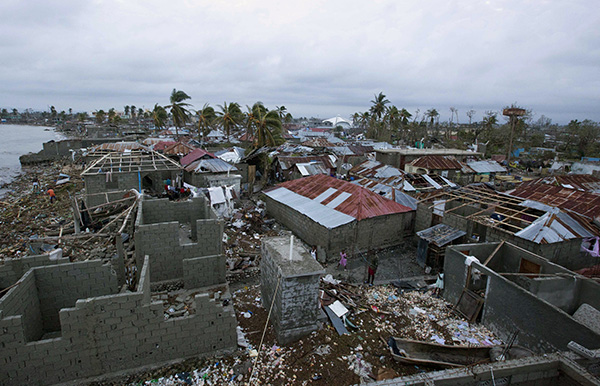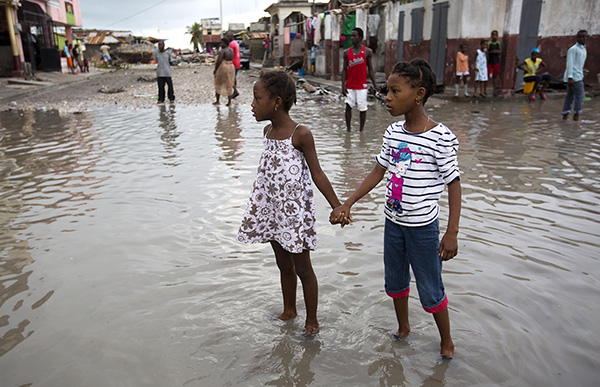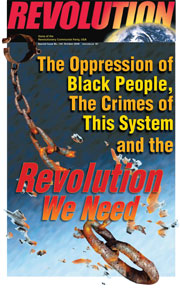Hurricane Matthew: A Horror in Haiti, A Cold-Blooded Response By the Rulers of the U.S.
October 10, 2016 | Revolution Newspaper | revcom.us

The main blow of Hurricane Matthew fell on the narrow Tiburon Peninsula that stretches like a finger from Haiti’s southeastern border with the Dominican Republic west into the Caribbean Sea. In Les Cayes, in this area, homes lay in ruins, October 6. (Photo: AP)

Two young girls in Les Cayes, Haiti, wade through a flooded street after the passing of Hurricane Matthew, October 6. Because of the isolation of the whole area and the lack of government infrastructure, reports of death and damage are still coming in, growing dramatically by the day. At this writing, close to 900 people are reliably reported to have died. (Photo: AP)
On October 4, Hurricane Matthew ripped through Haiti with 145 mile-by hour winds and up to 40 inches of rain. The storm hit many areas of the country, including the rural northwest, the densely populated capital of Port-au-Prince and the rice-growing Artibonite Valley. But the main blow fell in the southwest, on the narrow Tiburon Peninsula that stretches like a finger from Haiti’s southeastern border with the Dominican Republic west into the Caribbean Sea. 1.5 million people were in its direct path, and millions more felt punishing rain, flood, and tropical storm-level winds.
Photos of Jérémie, a small city on the western tip, show utter devastation—over 80 percent of its structures were leveled or heavily damaged, and there are reports of major destruction from other cities in the region.
The majority of people on the Peninsula live in rural areas, in small farming villages in the rugged mountains, on coastal farms or in fishing villages, eking out a living day to day, month to month, year to year. In the hilly village of Chantal the mayor said that 86 people died and 20 more were still missing. Reuters News Agency reported: “’A tree fell on the house and flattened it, the entire house fell on us. I couldn’t get out,’ said driver Jean-Pierre Jean-Donald, 27, who had been married for a year. ‘People came to lift the rubble, and then we saw my wife who had died in the same spot,’ Jean-Donald said, his young daughter by his side, crying ‘Mommy!’”
The southwest was already isolated before the storm. Imperialist investment and the political power that serves it are concentrated in and around Port-au-Prince and a few other areas in central and northern Haiti. From the standpoint of Western capital, there was little profit to extract from the small farmers in the south, and therefore little reason to develop roads, communication or other infrastructure there.
With the storm, phone lines, cell service and electricity, already spotty, went down completely. And even worse, the one road (yes, one road) connecting over a million people to the rest of the country became impassable when a single bridge washed out, and many secondary roads were also blocked by fallen trees. People in the rest of the country tried desperately to reach their loved ones by phone and could not, so many set out on foot and cars to cross the dangerous storm-swollen rivers to return home to help.
Because of the isolation of the whole area, the lack of government infrastructure, and the isolation of many mountain villages, reports of death and damage are still coming in, growing dramatically by the day. At this writing, close to 900 people are reliably reported to have died.
But the disaster goes far beyond those deaths. Hundreds of thousands of farmers work very small plots of land, owning at most a few pigs, goats or work animals. Their backbreaking work provided not only for the bare survival of their own families, but also a significant part of the food supply for the rest of Haiti, growing bananas, mangoes, corn, sugar, and cassava, a root vegetable which is a major staple of the Haitian diet.
Tree crops like bananas and coconuts were ripped apart by heavy winds, with crops thrown to the ground to rot—estimates are that 80 percent of tree crops were destroyed. Near the coast, the sea flooded over the fields, not only destroying crops, but poisoning the soil with salt, making it impossible to replant. Work animals and livestock were killed—for Haitian farmers, a goat or a pig is like a “piggy bank” that can be sold when cash is needed for a wedding, a funeral, education or an emergency; now this bare reserve built up over years has been swept away.
And all this is in addition to people’s homes being destroyed. In Chantal, the deputy mayor said “We have nothing left to survive on, all the crops have gone, all fruit trees are down. I don’t have a clue how this is going to be fixed.”
In the mountains it is likely that there have been and will be further destruction caused by mudslides, destroying both crops and villages; this danger is especially great because Haiti’s mountains have been stripped of trees over many decades by peasants compelled by extreme poverty to cut the trees to make charcoal (saleable as fuel). With no tree roots to hold the soil, heavy rains can bring tons of mud sliding off the hills.
Striking drone footage shows the devastation #Hurricane Matthew unleashed on #Haiti pic.twitter.com/PK1DFRA7WY
— AFP news agency (@AFP) October 9, 2016
All this not only foretells great suffering among the people hit by the storm, but the likelihood of food shortages and price hikes in the rest of Haiti—a country where malnutrition and hunger already stalk millions, including hundreds of thousands of children.
Before Hurricane Matthew, the Haitian people were already facing a situation of extreme poverty and dislocation—especially since the 2010 earthquake, which devastated the country and killed at least 100,000 people.
Haiti has the highest poverty rate in the world. Many suffer from malnutrition. Even before the earthquake hit, 1.9 million people were in need of food assistance and some 60 percent of the population lived on less than $1 a day. Only 50 percent of the people have access to water through a hand pump or a well and 80 percent do not have adequate sanitation available. Only 50 percent of children living in Haiti are able to go to school. (borgenproject.org)
At the time of the 2010 earthquake, speaking of the U.S. role in Haiti, Bill Quigley, legal director at the Center for Constitutional Rights, said: “We have kept the country dependent. We have kept the country militarized. And we kept the country impoverished. We have dumped our excess rice, our excess farm produce and that stuff on the country, thereby undercutting the small farmers who would make up the backbone of the place... We didn’t create the earthquake, but we created some of the circumstances that made the earthquake so devastating....” (Democracy Now!, January 14, 2010)
The government is extremely weak, corrupt and unstable, lurching from crisis to crisis in the wake of decades of U.S.-backed dictatorships, coups and invasions. A human rights leader said the current interim government lacks the “power or legitimacy to control the country.” At least 55,000 people made homeless by the 2010 earthquake were still living in tents when the hurricane hit, and unemployment is close to 70 percent!
There have been recurring outbreaks of cholera, a deadly water-borne illness which was introduced to Haiti by UN occupation troops who dumped their raw sewage into Haiti’s rivers—cholera has killed at least 10,000 Haitians in recent years.
Now the storm poses the immediate threat of the lack of drinkable water and epidemic disease. On the one hand, the sea has flooded in, contaminating fresh water with salt. And on the other hand, rains have flooded sewage systems and latrines, mixing raw sewage infected with cholera and other diseases into the drinking water. Within three days of the storm, at least seven people had died of cholera linked to sewage contaminated water. The Pan American Health Organization said, “Cholera cases are expected to surge after Hurricane Matthews and through the normal rainy season until the start of 2017.”
Through all this, the Haitian people have struggled to aid one another as best they can. There were dramatic pictures of stronger people carrying others on their backs across turbulent rivers. Teams of young people took to the streets with machetes and power saws to clear fallen trees. Those with homes still standing filled up with neighbors and relatives who had lost theirs. In the town of Cavaillon, Bellony Anazon said “My house wasn’t destroyed, so I am receiving people, like it’s a temporary shelter,” but added that she had no food to give people.
In the face of all this, the response of the U.S. and other great powers—who have long feasted on Haiti in various ways, while violently enforcing a distorted and backward economic structure and a series of reactionary and ineffective governments—has been a) slow, b) tokenistic, and c) focused on “security.”
It took two days for the U.S. Ambassador to Haiti to do an exploratory flyover and “observe” that there was a lot of destruction and that helicopters were needed to deliver aid. (Which was obvious from the day of the storm when the only road washed out.) The day after that, the U.S. promised nine transport helicopters to assist in delivering aid to over a million people spread out over a large area, and two days later USAID promised a shipment of blankets and sanitary supplies that it said would provide some help for 100,000 people.
Given the tremendous wealth and technical resources of the U.S. (for instance, the U.S. military has over 2,500 helicopters that could potentially be used for transporting aid, many stationed just 600 miles away in South Florida), the fact that Haiti is its neighbor and the long-time predatory relationship between the U.S. and Haiti, these efforts are puny and paltry—they are like a billionaire tossing crusts of bread to a crowd of starving people, going through the motions of pretending to care.
Not only has aid so far been minimal, but at the same time the U.S. is cold-bloodedly slamming the door on Haitians trying to enter the U.S. Thousands who resettled in Brazil after the earthquake have now been forced to emigrate north because of the economic collapse in Brazil and are waiting on or heading for the Mexican border. With news of the hurricane—and sometimes with news of loved ones who have lost everything and whose very survival is at stake—these migrants are desperate to find jobs and the ability to send some money home.
But not only has the U.S. so far refused to admit these refugees, it is threatening to deport thousands who came to the U.S. after the earthquake. According to the Department of Homeland Security, conditions in Haiti have “improved sufficiently” that Haitians can safely return... while the U.S. State Department issues warnings to American tourists to stay away from Haiti because it is unstable and dangerous!
While the U.S. is said to be “monitoring” the situation and considering halting deportations, Obama is reportedly “defensive” in the face of Donald Trump’s anti-immigration ranting—even though Obama himself has justly been called “The Deporter-in-Chief” because of his record-breaking numbers of deportations of immigrants from Mexico and other countries.
One thing the U.S. does readily have resources for is political and military control. The day after the storm, before announcing any help for the survivors, the U.S.—which has a whole history of occupying Haiti with U.S. troops—declared that it would send several hundred troops to Haiti, with headquarters in Port-au-Prince that would “coordinate” efforts. And it also positioned an aircraft carrier off the coast, although they had received no request from Haiti for such “aid.”
While massive suffering engulfs hundreds of thousands in Haiti, the primary concerns of the U.S. flow, not out of concern for the Haitian people, but to be able to respond to any political instability, including flows of refugees fleeing the area that might result.
Volunteers Needed... for revcom.us and Revolution
If you like this article, subscribe, donate to and sustain Revolution newspaper.







